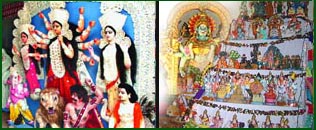Navarathri means nine nights. Although it has different names in different parts of India, Hindus from all regions celebrate it with great enthusiasm as the conquest of good over evil. The festival is celebrated during the first nine days in the right half of Aswina or September -October. The last 3 days are called Durgashtami, Mahanavami and Vijayadasami and they are considered more sacred than the other days for Devi worship.
|
|
H\zXp Znhks¯ DÕhamWv
\hcm{Xn. `mcX¯nsâ Fñm`mK§fnepw Cu DXvkhw ]e t]cpIfnð BtLmjn¡póp. tIcf¯nð ZpÀ¤mãan, alm\han, hnPbZian Fóo Znhk§fnemWv km[mcWbmbn Cu \hcm{Xn DÕhw BtLmjn¡póXv.
"]qPhbv]v' Fó t]cnð CXv Adnbs¸Spóp.
|
In Kerala, Saraswathi Puja and Ayudha Puja are performed. The Goddess Saraswathi is worshipped as the Goddess of Learning, the deity of Gayathri, the fountain of five arts and science and the symbol of supreme vedantic knowledge. The importance of Ayudha puja may be due to the fact that on the Vijayadasami day, Arjuna took back his weapons which he had hidden in a vani tree in order to lead a life in disguise for the promised period of excile.
|
|
 |
It is believed that one who begins or resumes his learning on Vijayadasami day will secure a grand success as Arjuna did in Kurukshethra .
On the Durgashtami day a ceremony called Poojavaipu is performed in the evening. In a well decorated room, books and grandhas (holy books) are tastefully arranged in front of picture or an image of Goddess Saraswathi. Sometimes weapons or implements are kept by the side of the books. A puja is performed to Saraswathi during which fruit, beaten rice, malar, jaggery etc are offered and later distributed among those present. The following day, Mahanavami, is totally devoted to the worship of Saraswathi.
Puja is performed in the morning and in the evening rice, payasam, chundal, athirali etc are offered to Devi.
On the Vijayadasami day, after a Puja in the morning the books and implements are removed from the room and this ceremony is called 'Puja Eduppu'. The time for the break up of the Puja marks the beginning of learning and work and this moment is considered auspicious. The children write the alphabets on sand and read a few sentences from sacred books. Similarly the craftsman and other skilled workers do some work using their implements. According to custom it is only after this ceremony that the children are entitled to read or write.
There are certain communities which celebrate the festival on all days of Navarathri. Images of Gods, toys and animals of different variety are arranged and it is called 'Koluvaipu'.
At the Sree Padmanabhaswami Temple at Thiruvananthapuram, apart from the usual pujas and rituals, classical music recitals are held on the Navarathri mandapam every night during the festival in which luminaries of carnatic music participate.
|
|
hnZymtZhXbmb kckzXnsbbmWv P\§Ä ]qPn¡pI. kckzXn tZhnbpsS ap¼nð ]pkvXI§Ä h¨p ]qPn¡póp. hnPbZian ZnhkamWv kckzXn
]qPsbSp¸v. Aóp cmhnes¯ ]qP Ignªv Fñmhcpw AhchÀ ]Tn¨sXms¡ Ipd¨pt\cw A`ykn¡póp. ]Tn¨p XpS§m¯ sIm¨p Ipªp§sf Fgp¯n\ncp¯póp. tZhnbpsS ap¼nð sh¨v "lcn{io KW]Xmsb \ax' FsógpXn¡póp. CXmWv hnZymcw`w. AópsXm«v B Ip«nIÄ ]Tn¨p XpS§póp.
hn\mbI NXpÀ°n, AãantcmlnWn,
Zo]mhen, Xr¡mÀ¯nI, aÞe]qP, aIchnf¡v, inhcm{Xn, {iocma\han, Hm¨nd¡fn, kÀ¸¸m«v, Ifsagp¯p]m«v, Xnd Fón§s\ tIcfobÀ BtLmjn¨p hcpó DÕh§fpw hntij§fpw A\h[nbmWv.
|